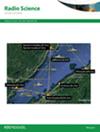A novel blind adaptive 3D beam steering algorithm for interference mitigation and performance enhancement in massive MIMO systems
IF 1.5
4区 地球科学
Q3 ASTRONOMY & ASTROPHYSICS
引用次数: 0
Abstract
This paper introduces an innovative blind adaptive 3D Beam steering algorithm designed to mitigate interference, ultimately improving the signal-to-interference and noise ratio (SINR) to enhance the overall performance of mMIMO (massive multiple-input multiple-output (MIMO)) networks. The proposed algorithm combines an optimized direction of arrival (DoA) estimation method with an inventive adaptive signal processing technique. To address the computational complexity associated with determining the 2D-DoA of incoming signals, an improved RD-MUSIC (Reduced Dimension — Multiple Signal Classification) estimator is proposed. This method streamlines the process into an efficient 1D search, significantly reducing computational overhead compared to conventional 2D-MUSIC and minimizing noise, maintaining superior accuracy over the conventional RD-MUSIC method. Leveraging the estimated 2D-DoAs, the proposed adaptive signal processing technique integrates the Dolph-Chebyshev weighting method with nulling constraints to calculate the optimal complex weig0hts necessary to accurately steer the main Beam toward the desired signal direction and create deep nulls in the directions of interfering signals, resulting in enhanced SINR. Compared to alternative algorithms, our approach demonstrates superior performance and offers an efficient solution without requiring a training signal or additional antenna elements. This is advantageous, particularly in environments with intense interference and high mobility, making it a promising candidate for future wireless systems.大规模MIMO系统中一种新的盲自适应三维波束引导算法
本文介绍了一种创新的盲自适应三维波束引导算法,旨在减轻干扰,最终提高信噪比(SINR),从而提高mMIMO(大规模多输入多输出(MIMO))网络的整体性能。该算法结合了一种优化的到达方向估计方法和一种新颖的自适应信号处理技术。为了解决确定输入信号二维doa的计算复杂性,提出了一种改进的RD-MUSIC(降维-多信号分类)估计器。该方法将过程简化为高效的一维搜索,与传统的2D-MUSIC相比,显著降低了计算开销,并将噪声降至最低,保持了优于传统RD-MUSIC方法的精度。利用估计的2d - doa,提出的自适应信号处理技术将dolphor - chebyshev加权方法与零化约束相结合,计算出精确引导主波束向所需信号方向所需的最优复杂权重,并在干扰信号的方向上产生深零,从而提高信噪比。与其他算法相比,我们的方法表现出卓越的性能,并且在不需要训练信号或额外天线元件的情况下提供了有效的解决方案。这是非常有利的,特别是在具有强烈干扰和高移动性的环境中,使其成为未来无线系统的有希望的候选者。
本文章由计算机程序翻译,如有差异,请以英文原文为准。
求助全文
约1分钟内获得全文
求助全文
来源期刊

Radio Science
工程技术-地球化学与地球物理
CiteScore
3.30
自引率
12.50%
发文量
112
审稿时长
1 months
期刊介绍:
Radio Science (RDS) publishes original scientific contributions on radio-frequency electromagnetic-propagation and its applications. Contributions covering measurement, modelling, prediction and forecasting techniques pertinent to fields and waves - including antennas, signals and systems, the terrestrial and space environment and radio propagation problems in radio astronomy - are welcome. Contributions may address propagation through, interaction with, and remote sensing of structures, geophysical media, plasmas, and materials, as well as the application of radio frequency electromagnetic techniques to remote sensing of the Earth and other bodies in the solar system.
 求助内容:
求助内容: 应助结果提醒方式:
应助结果提醒方式:


